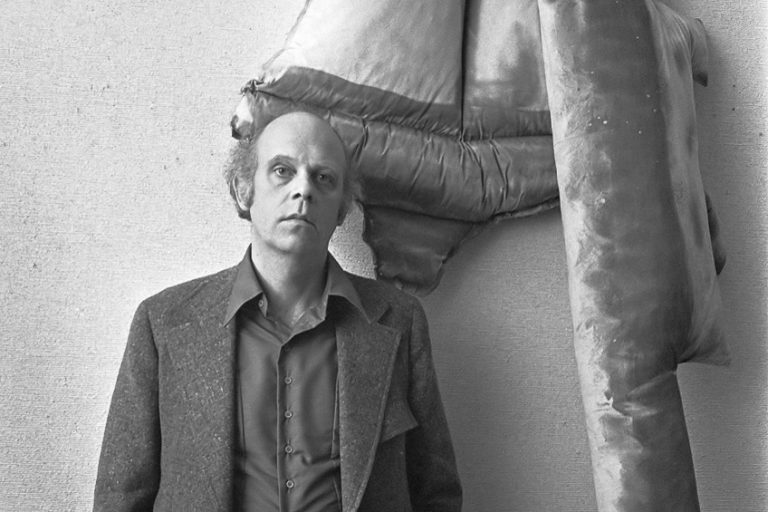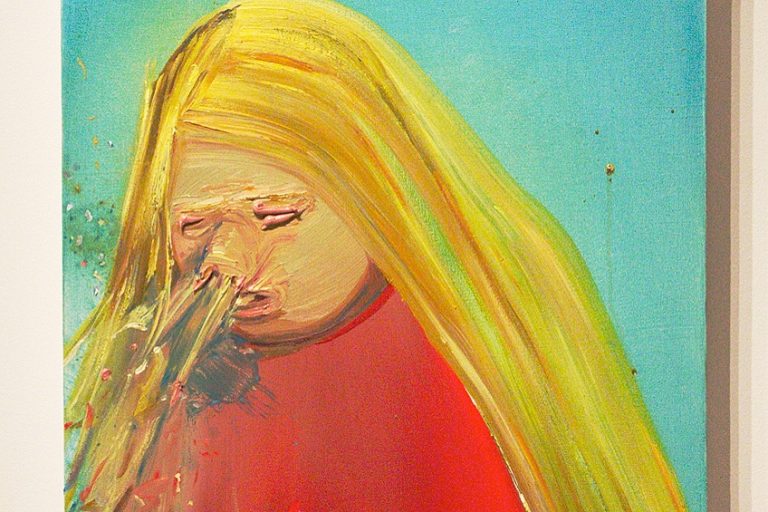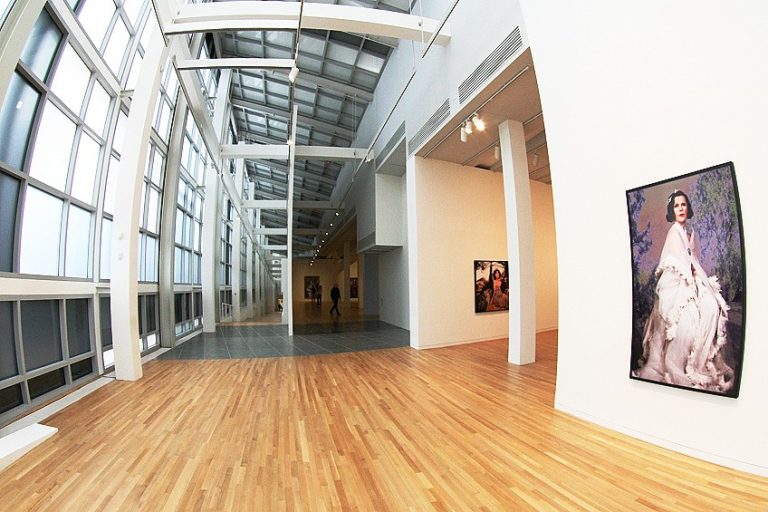Jeff Koons – Exploring the Life and Art of Jeff Koons
You may be familiar with the shiny metallic-coated balloon dog figures or remember the headlines of the $91.1 million rabbit sculpture. You would be correct in thinking of none other than the iconic Jeff Koons, who remains one of the Contemporary art world’s most sought-after artists. In this article, we will be unpacking the life of the artist through a Jeff Koons biography, including some of his most popular series and artworks!
The Life and Art of Jeff Koons
Introducing the world’s most “original, controversial, and expensive” artist, Jeff Koons is one of the biggest names in modern art history that has dominated the art scene since the 1980s. You may immediately associate Jeff Koons with his famous giant balloon dog sculptures and his record for being one of the highest-paid living artists for auction works. Jeff Koons is no doubt an artist you will want to learn more about and luckily for you, we have it covered! Below, we will delve into a complete Jeff Koons biography, including some of Jeff Koons’s famous paintings and artworks that have left a significant mark on art history.
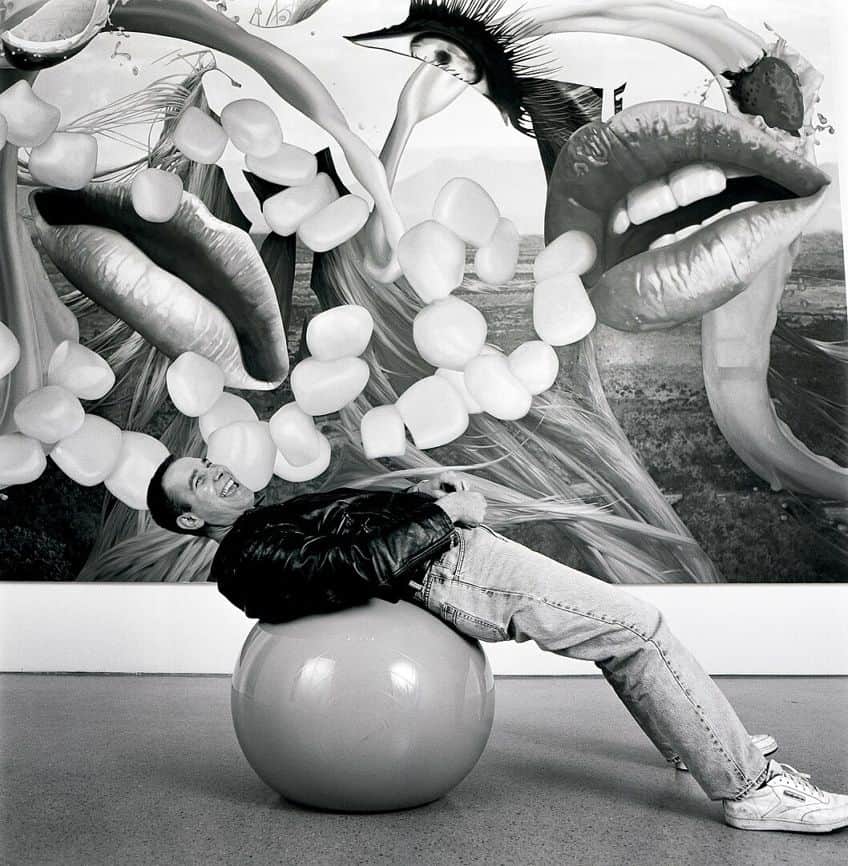
The Early Life of Jeff Koons
| Artist Name | Jeffrey Lynn Koons |
| Date of Birth | 21 January 1955 – Present |
| Place of Birth | York, Pennsylvania, United States |
| Nationality | American |
| Net Worth | $500 million (2022) |
| Associated Movements, Themes, and Styles | Contemporary, Modern, conceptual sculpture |
| Mediums | Sculpture and painting |
Born Jeffrey Lynn Koons in 1955, this famous American popular culture-driven artist was raised in York, Pennsylvania under the guidance of his parents, Henry and Gloria Koons who introduced Koons to the arts. At the spritely age of nine, Koons began copying masterworks for his father to attract visitors to his father’s store. His father, Henry, operated as both an interior decorator and furniture dealer. Koons’ introduction to earning money was also learned at a very young age.
After school hours, Koons would sell candy and gift-wrapping paper to his community to earn his own pocket money.
Entering his teenage years, Koons looked up to artists such as Salvador Dalí and it is reported that he was such a huge fan that he even visited Dalí at the St. Regis Hotel in New York. Koons was a driven young man from an early age, which one can assume, definitely set the trajectory for his later success and career choices.
Education and Early Art Career
Jeff Koons attended the Maryland Institute College of Art and the School of the Art Institute of Chicago where he gained the acquaintance of Ed Paschke. Koons joined Pashcke as a studio assistant in the 70s, learning from Paschke throughout his college days. Ed Pashcke was a prolific painter who influenced Koons’s growth in the field of painting and was a profound member of the Art Institute of Chicago. Following his death in 2004, a street was named after him between Michigan Avenue and Columbus Drive.

Towards the end of the 70s, Koons relocated to New York where he found employment at the Museum of Modern Art while working on establishing himself as an artist. His personal style was still very much informed by the great Dalí and he groomed himself with a pencil mustache and dyed his hair red. By the 80s, Koons made a detour as a Wall Street commodities broker selling mutual funds at the First Investors Corporation. Koons also worked as a political canvasser in Florida, dealing directly with other individuals during political campaigns. Koons then made his way back to New York where he became a commodities broker at Clayton Brokerage Company and Smith Barney.
Between 1977 and 1979, Koons created what he called his “early works”, which marked the beginning of his Inflatable series and by the mid-1980s, he gained further recognition and traction in the art world after joining a band of artists who questioned the meaning of art within a mass-media populated era.
Jeff Koons’ art originates from a place and mind informed by strategy and intention for how the cultural world impacts the role of the artist and vice versa. His work is reflective, energetically charged, and empowering for the viewer. While strolling through complex concepts, Koons not only highlights the power of the banal in popular culture and media, but he also illuminates human nature and the various aspects of life that are witnessed as moments of inflation and deflation.
Studio in SoHo
Jeff Koons founded his own studio in SoHo in the 1980s at the corner of Broadway and Houston Street, New York, where he employed just over 30 studio assistants to streamline his production process. Jeff Koons’ studio process involved the use of a Contemporary method called art fabrication, which involves the service or process of generating technically difficult or large artworks using resources and parties outside of the artist’s studio. Art fabrication companies assist artists with realizing their complex projects and can be incredibly useful when developing large-scale artworks. Recently, Koons decided to down-staff and adopt automated and efficient modes of production.

The Plagiarism Debate: Fait d’Hiver (1985)
In 2018, Jeff Koons was ruled guilty of plagiarism after he released a sculpture that appeared similar to that of a 1980s advertisement featuring a woman and a pig. Koons was involved in a four-year-long legal dispute with another artist who claimed that Koons essentially stole his work. The ad in question was a Surreal image called Fait d’Hiver created in 1985 for the French Naf Naf clothing brand. In 1988, Koons created a sculpture with the same title Fait d’Hiver but this time presented the figures in the ad as three-dimensional sculptures and included a penguin next to the pig while retaining a resemblance to the placement of the pig to the woman.
The ad campaign was created by Franck Davidovici who first saw Koons’ sculpture in 2014 at the Pompidou Center and thereafter took legal action based on copyright infringement.
Koons’ exhibition at the time involved the release of his Banality series from which Koons made sculptures from specific advertisements and various other items considered “kitsch”. After the show, Koons received around five lawsuits for plagiarism, which demonstrates the age-old question of plagiarism in art and what constitutes plagiarism, if not, inspiration and reference. Legally, the French copyright laws were stricter than the laws in the United States and resulted in Koons losing three of the cases. Koons produced three editions of the sculpture with one that sold for $4.3 million in 2007 and was placed in the Prada Foundation collection.
Famous Jeff Koons Sculptures
Sculpture has been an interesting site of experimentation for Jeff Koons. Koons has created many unique series that outline just how creative one can get with the medium of sculpture and how it can be used to relay complex themes and messages that pertain to Contemporary art history. Below, we will examine some of the most famous Jeff Koons sculptures that will enlighten you on the artist’s technique and perspective.

New Hoover Convertibles, Green, Red, Brown, New Shelton Wet/Dry 10 Gallon Displaced Double Decker (1981 – 1987)
| Date | 1981 – 1987 |
| Medium | Four vacuum cleaners, perspex, and fluorescent lights |
| Dimensions (cm) | 251 x 137 x 71.5 |
| Where It Is Housed | Joint acquisition by the National Galleries of Scotland and Tate Gallery, London, United Kingdom |
When Koons’ debuted on the art scene and grew to fame in the 1980s, he also exhibited one of the most fascinating sculptures, which consisted of four vacuum cleaners arranged in different ways within perspex boxes, which continued to last for several years. The multiple configurations of the work added to the conceptual backing and were presented as a series called “The New”. Koons employed a collection of readymade objects as sculptures placed under fluorescent lighting that elevated these seemingly ordinary objects.
Koons’ comment on the work followed “if one of my works were to be turned on, it would be destroyed”, thus solidifying the entire concept of the sculpture’s existence within a few words.
Three Ball Total Equilibrium Tank (Two Dr. J Silver Series, Spalding NBA Tip-Off) (1985)
| Date | 1985 |
| Medium | Glass, steel, pneumatic feet, 3 rubber basketballs, and water |
| Dimensions (cm) | 153.6 x 123.8 x 33.6 |
| Where It Is Housed | Tate Gallery, London, United Kingdom |
Three Ball Total Equilibrium Tank is one sculpture out of a series of sculptures belonging to Koons’ Equilibrium series, which he began in the mid-1980s and which formed part of the body of work on his first solo exhibition. The series featured tanks and glass vitrines supported by black steel stands containing professional basketballs. The tanks were filled with distilled water and included an addition of sodium chloride reagent to keep the basketballs suspended. Koons also created a series of posters to accompany the tank sculptures, which involved a collaboration with Nike and portrayed popular American basketball players donning new Nike trainers surrounded by basketballs.
The basketballs represented “an ultimate state of being” that, coupled with the Nike advertisement, was a balance between that state of being and “the great deceivers” who cheer on and encourage others to “achieve”.
The underlying message of the entire experience was that death was the final state of being and was further reiterated by the bronzes from one of the series’ sculptures 50/50 Tanks. Koons’ intention was also aimed at highlighting the effect that advertising has, specifically on children, and how white middle-class children utilize art in the same way that children from ethnic backgrounds utilize basketball for social mobility. He further draws attention to the comparison made when children view a celebrity or politician in advertising tied to popular brands and how advertising carries the potential for not only propaganda but mass influence. What do you think of his viewpoint?

Balloon Dog; Celebration Series (1993; 1994 – 2000)
| Date | 1993; 1994 – 2000 |
| Medium | Mirror-polished stainless steel with transparent color coating |
| Edition | 5 (blue, yellow, magenta, orange, and red) |
| Dimensions (cm) | 307.3 x 363.2 x 114.3 |
| Where It Is Housed | Various locations; The Broad, Los Angeles, United States; Château de Versailles, France |
The most famous Jeff Koons sculpture is none other than the Balloon Dog sculpture from his Celebration series, which debuted in 1993 and has since been incredibly sought after well into the 21st century. These quirky steel sculptures mimic the visual and textural quality of an inflatable balloon and take the shape of a dog. Since 1993, Koons has produced many large and small-scale Balloon Dog sculptures, with his orange Balloon Dog selling for $58.4 million in 2013 at a Christie’s auction.
Koons’s replication of a popular trope seen at funfairs and circus events forms an integral part of childhood for many adults and the image of a gentle balloon dog blown out of proportion is what amplifies the impact of his work.
It is an elevation of joy yet the sculptures themselves are hollow objects that offer more space for meaning-making than statements. Koons’s use of a reflective surface also unifies his consistent approach to engaging the viewer not only emotionally, and perhaps subconsciously, but also visually. One cannot look at a Jeff Koons artwork and not “experience” it.
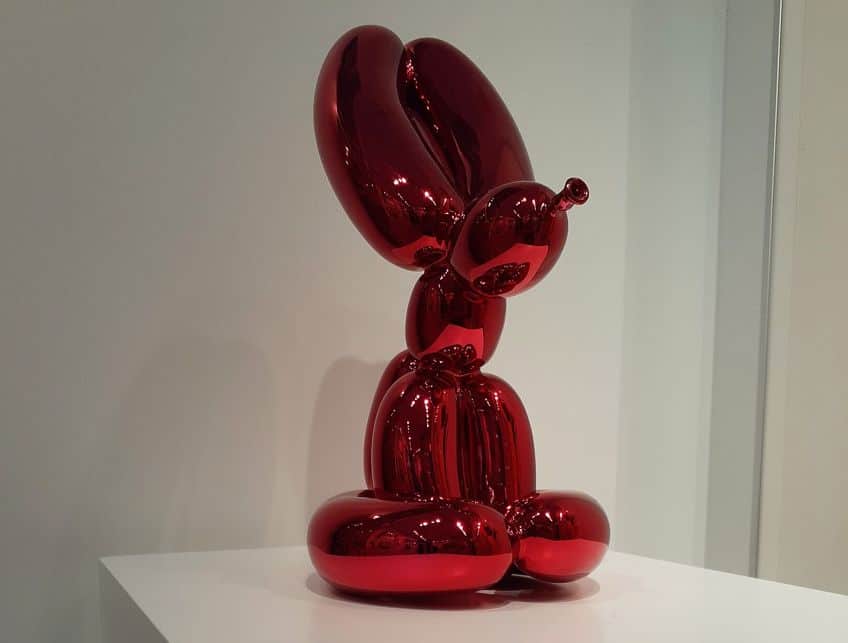
Famous Jeff Koons Paintings
Now that you have some background into one of the best Contemporary sculptors of the 21st century, let us explore some of the most famous Jeff Koons paintings. Below, we have selected the top three Jeff Koons paintings that will provide insight into the mind and artistic interests of Jeff Koons.

Triple Hulk Elvis III (2007)
| Date | 2007 |
| Medium | Oil on canvas |
| Dimensions (cm) | 275 x 213.4 |
| Where It Is Housed | Private collection; acquired from Gagosian Gallery, London, United Kingdom |
Triple Hulk Elvis III is a famous Jeff Koons painting currently housed at The Broad in Los Angeles. The painting portrays the famous Neo-Art style popularized by Koons through a combination of recognizable popular cultural imagery arranged and layered over each other. The painting was sold for $2.4 million on auction at Christie’s in 2010 and was created in 2007 as part of a series called Hulk Elvis, which contains the motif of an inflatable Incredible Hulk toy that is also represented in 16 other canvas works by Koons.
Koons initially took to painting after his Celebration sculpture series was delayed and this allowed him to develop his concept and let his paintings stand on their own in a way that allows his painting to carry the same weight in terms of value as that of his large-scale sculptures, for which he is so famously known for.
The painting, Triple Hulk Elvis III, presents multiple allusions, which Koons is also notorious for. He intended to evoke the familiar and then subvert its function to make it seem strange again through layering images and confusing the viewer’s “view”. Here, Koons also refers to Andy Warhol, another icon of the Pop Art movement through the insertion of Elvis countered by the “global archetype”, Hulk.
The image of the hulk alludes to the Asian guardians or entities that are placed before edifices to protect people and display intimidating poses and facial expressions. Koons’ emphasis on the idea of an inflatable is also seen in the plastic texture of the green figure and alludes to a symbol of plentitude, a “container for breath”, and “fullness”. The image of the hulk is also appropriate to Koons’ concept since he is a symbol of controlled power described in the comic book as the alter ego of a scientist who gets exposed to gamma rays in an experiment gone wrong and turns into a green monster.
Waterfall Couple (Dots) Blue Swish with Red Stroke (2009)
| Date | 2009 |
| Medium | Oil on canvas |
| Dimensions (cm) | 274.3 x 371.1 |
| Where It Is Housed | Pace Gallery, Los Angeles, United States |
Waterfall Couple (Dots) Blue Swish with Red Stroke is one of Jeff Koons’s rarest artworks that formed part of a collection of paintings exhibited in 2009. Here, Koons focused on a conversation between cultural history and art history that resulted in these abstract thought-provoking waves of color placed across the canvas. Koons’ gestural mark-making in the painting is reminiscent of figurative painting and contains “fake brushstrokes” that appear photorealistic yet are rendered in a Roy Lichtenstein style.
Koons also draws reference to the visual abstraction found in the paintings of Cy Twombly, which alludes to the way that an artist existentially questions their role as an artist or cultural practitioner.
The dots on the artwork create a holographic effect that provides depth to the painting and is compared to the depth of field seen in Gustave Courbet’s L’Origine du Monde (1866). The dots are also representative of old technologies such as color television that denote a sense of change and transition while paying homage to mortality. The painting is thus reflective of Koons’ exploration of sexuality and cultural history that makes clear the relationships between the past, the present, and the future.
Titian Pastoral Concert; Gazing Ball Series (2016)
| Date | 2016 (series: 2012 – Present) |
| Medium | Oil on canvas, glass, and aluminum |
| Dimensions (cm) | 152.4 x 188 x 37.5 |
| Where It Is Housed | Gagosian Gallery, Los Angeles, United States |
Many have seen Jeff Koons’ famous large-scale sculptures, but not many have indulged in his paintings. “I like to think that when you leave the room, the art leaves the room. Art is about your own possibilities as a human being. It’s about your own excitement, your own potential, and what you can become. It affirms your existence.” This is a famous quote by Koons that reiterates the mindset through which he creates and helps his audience understand the ephemeral quality and impression he wishes to leave in his art.
This famous Jeff Koons painting is part of a series called the Gazing Ball painting series that references some of the most well-known paintings in art history in direct conversation with Koons’ addition of a blue-mirrored hand-blown glass ball with a reflective surface.
The Gazing Ball series attracts viewers through the initial encounter with familiarity and then intensifies the experience by inviting viewers to gaze at their environment. Here, Koons amplifies the experience of the viewer by adding the gazing ball that not only reflects, but also invites viewers to inspect these grand paintings themselves.
Important Exhibitions and Collections
Jeff Koons’ art is held in many prestigious art collections, including institutions such as the Museum of Modern Art, the Solomon R. Guggenheim Museum, the Stedelijk Museum, the Tate Gallery, and the Tokyo Museum of Contemporary Art. Some of Jeff Koons’s most important exhibitions include a massive retrospective exhibition held at the Whitney Museum of American Art in 2014, which featured more than 100 Jeff Koons sculptures. This was Koons’ largest museum presentation in New York with the exhibition then traveling to Paris at the Centre Georges Pompidou and then the Guggenheim Museum Bilbao in Spain.
It was at Koons” major retrospective that his most controversial sculpture of the pop star Michael Jackson and his pet monkey was exhibited. For Koons, Michael Jackson represented “a spiritual authority who could help people feel secure in embracing their culture”. Koons’ received a great deal of criticism over the sculpture despite Jackson supporting the project. Koons began creating a sculpture of Michael Jackson and his pet, Bubbles, during a period when the musician was undergoing many plastic surgeries and had to “keep up with the different images”. Koons’ attempted to emulate the image of the popular religious trope of Madonna and Child with Michael and Bubbles.
What made the sculpture controversial was its feminine nature and shocking white-skinned porcelain face that took fans by surprise. There were also issues surrounding the representation of an African-American man as a white man in art.
In 2020, Koons’ Jeff Koons: Absolute Value / From the Collection of Marie and Jose Mugrabi was held at the Tel Aviv Museum of Art where Koons’ exploration of the Absolute Value was showcased through artworks and sculptures he created at different points in time. The term “absolute value” was used in reference to a mathematical concept referring to size where “the absolute value of a number is the distance between the number and the “0-point” on the number axis.”. The mention of a mathematical concept of value in the title of the exhibition resurrected crucial questions about the value of Jeff Koons’ art, including important questions on the value that society places on the attribution of value to art objects. Concerning Koons, the idea of value is questioned in the interrogation of the distance between the different artworks and in relation to the different points in time that “separate” them as well as their absolute value concerning the broader context of art history.
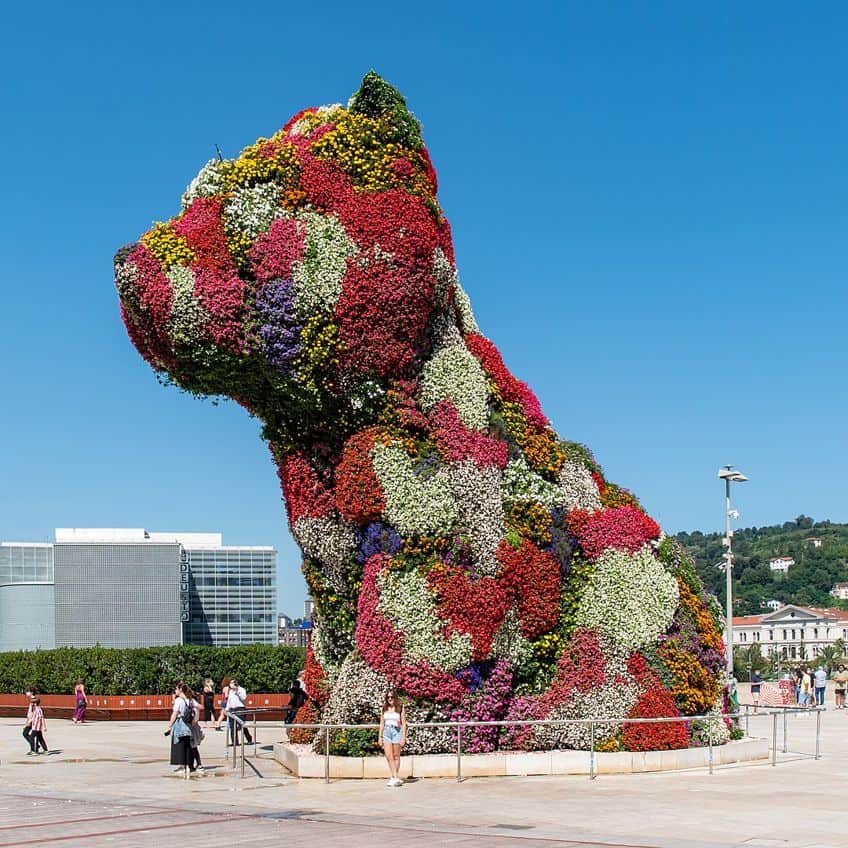
Since 2021, Jeff Koons cut ties with his former galleries David Zwirner and the Gagosian Gallery to collaborate exclusively with Pace Gallery, In 2022, Koons was also involved in another copyright infringement case with sculptor Michael Hayden who claimed that Koons’ stole an original sculptural work of a serpent wrapped around a rock in Koons’ Made in Heaven series. In addition to being one of the world’s most controversial artists, Jeff Koons may also be taking his sculptures to the moon for a permanent exhibition after it was announced in 2022 that he would be collaborating with NASA and Elon Musk on a major project. In an interview with Laura Schreffler from Haute Living, Koons comments on the potential of art as it stands today, stating that “the art world has become very vast; there are opportunities for so many to participate now… incredible technologies… the personal computer, the internet, NFTs. I think being part of a group is so important in the sense of belonging.”
Recommended Reading
Jeff Koons’ art is definitely worth studying further since it offers not only the necessary room for questioning what we consider to be controversial but also presents us with vital questions on the way that art, sculpture, and painting are examined in relation to popular culture and economics.
Below, you will find two of the most highly-rated book recommendations for further insight into the world and art of Jeff Koons.
Jeff Koons: Conversations with Norman Rosenthal (2014) by Jeff Koons and Norman Rosenthal
If you are a lover of Jeff Koons, then you will enjoy this rigorous discussion between Jeff Koons and art curator Sir Norman Rosenthal that was released alongside the artist’s 2014-2015 retrospective. This book is the perfect read for any art critic or fan of Koons since it covers not only a two-way discussion between curator and artist, but also gives fans of Koons’ art insight into his early life and personal thoughts on self-acceptance, sexuality, and some of the most important concepts from his professional oeuvre.
The book contains more than 250 full-color illustrations that will keep you extra engaged!
- A lively conversation between Jeff Koons and Norman Rosenthal
- Complements the 2014-2015 Jeff Koons Retrospective
- Insight into the early life and professional career of the artist
Jeff Koons: Gazing Ball (2014) by Jeff Koons and Francesco Bonami
This book is the first catalog of Jeff Koons’ art published by David Zwirner as an accompanying piece to the artist’s 2013 debut of the Gazing Ball series in New York. This publication is the ideal addition for those who cannot stop admiring Koons’ Gazing Ball series and provides stunning visuals and insight into Francesco Bonami’s reflection on Koons’ work that touches on the fragility of the Gazing Ball series and the relationships between mass culture, fantasy, materiality, and history.

- Explores the cultural relationships underpinning the Gazing Ball Series
- A comprehensive catalog of this stunning series of artworks
- Comes with insightful commentary by Francesco Bonami
Jeff Koons can easily be criticized for his artworks and approaches to incorporating the “kitsch”, yet his methods and thinking around certain artworks leave viewers with a sense of critical thinking around the role of the artist and how an artist may or may not escape the society and culture they critique. Jeff Koons’ art is a double-edged sword that simply presents and provokes, which is necessary for the Contemporary era and encourages further critical growth.
Frequently Asked Questions
Who Is Jeff Koons?
Jeff Koons is one of the most famous American artists who specializes in sculpture and painting. Jeff Koons’s art touches on subject matter relating to popular culture, the use of found objects, and concepts that incite critical thinking around mass culture.
Why Is Jeff Koons Controversial?
Jeff Koons is considered to be a controversial artist who has been criticized for promoting the objectification of women in his art and using expensive materials to create artwork that is aesthetically deceptive. Art critics have also criticized Koons for capitalizing off his artwork by intentionally selecting costly materials, which contradict his concept of mass-culture and capitalism that he deals with.
What Is the Most Expensive Jeff Koons Artwork?
In 2022, Jeff Koons’ Balloon Dog (Magenta) was auctioned off for $121.9 million as part of a project to raise funds for recovery relief in Ukraine. Before the relief-fund contribution, Rabbit (1986) was the artist’s most expensive artwork, which sold for $91 million on auction.
Isabella studied at the University of Cape Town in South Africa and graduated with a Bachelor of Arts majoring in English Literature & Language and Psychology. Throughout her undergraduate years, she took Art History as an additional subject and absolutely loved it. Building on from her art history knowledge that began in high school, art has always been a particular area of fascination for her. From learning about artworks previously unknown to her, or sharpening her existing understanding of specific works, the ability to continue learning within this interesting sphere excites her greatly.
Her focal points of interest in art history encompass profiling specific artists and art movements, as it is these areas where she is able to really dig deep into the rich narrative of the art world. Additionally, she particularly enjoys exploring the different artistic styles of the 20th century, as well as the important impact that female artists have had on the development of art history.
Learn more about Isabella Meyer and the Art in Context Team.
Cite this Article
Isabella, Meyer, “Jeff Koons – Exploring the Life and Art of Jeff Koons.” Art in Context. June 1, 2023. URL: https://artincontext.org/jeff-koons/
Meyer, I. (2023, 1 June). Jeff Koons – Exploring the Life and Art of Jeff Koons. Art in Context. https://artincontext.org/jeff-koons/
Meyer, Isabella. “Jeff Koons – Exploring the Life and Art of Jeff Koons.” Art in Context, June 1, 2023. https://artincontext.org/jeff-koons/.





